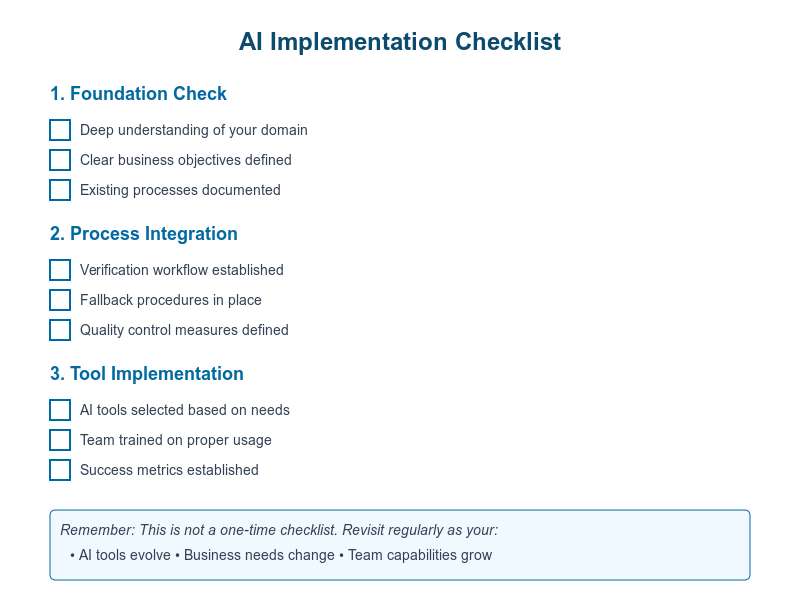AI Confessions: A Guide from Both Sides of the Prompt - Part 2
When Humans Think They Can Just Wing It (And Their AI Assistant Has to Watch in Horror)
Dear aspiring AI whisperers - after letting Claude steal the spotlight in Part 1 with their endearingly neurotic self-analysis (and apparent addiction to bullet points), it's time for some hard truths from the human side of the equation, so it´s me again Barbara aka AI Babsi, today again in AI Therapist mode.
And since AI readability and human need for what do I get here matches quite well, here are your Key Takeaways:
Why most common AI implementation approaches fail in business contexts
How to avoid the three major AI implementation traps: Tool Obsession, Autopilot Fantasy, and Incomplete Integration
A practical framework for implementing AI in your professional context, regardless of your technical background
Strategic preparation for upcoming AI developments (including AI agents) while maintaining business continuity
The machine recommended also adding this, what do we think?
Target Audience: Business professionals implementing AI tools
Prior Knowledge Required: Basic familiarity with AI tools (Part 1 recommended but not required)
First things first, if you came here today expecting a quick "Top 10 Prompts to Master AI" guide that'll turn you into an AI overlord or goddess by lunchtime – I'm sorry, really! I would love to write some comfort content for you, but here we are again me being in AI Therapist mode!
The Real Homework Nobody Wants to Do (But Must)
Before we dive into what's going wrong, let's establish what actually works. Want to know the secret to mastering AI tools? It's not in the prompts. It's not in the latest API documentation. It's in the boring, unsexy, fundamental understanding of your field.
What Actually Works (From Someone Who's Seen Both Sides):
Start With What You Know
Use AI in your area of expertise first
Build your BS detector on familiar ground
Learn to spot AI hallucinations in your field
Example: That time an AI confidently explained a marketing concept that doesn't exist to a room full of CMOs
Think Systems, Not Tools
Build verification into your workflow
Create fallback procedures
Document your processes
Real example: A content team that reduced errors by 80% by creating a simple three-step verification process
Understand Your Context
Personal blog? Go wild.
Professional communication? Add safeguards.
Enterprise setting? Consider the broader implications.
Common Pitfalls: The Three AI Implementation Traps
The Tool Trap - or what Copilot Really Means
Picture this familiar scene: You've discovered AI tools. You're feeling pretty good about yourself. You've mastered the art of prompt crafting. Your outputs are getting better. You're saving time! You're being more productive!
Then it happens.
That moment when your AI-generated report confidently cites a paper that doesn't exist. Or when your carefully crafted customer email references product features from 2021. Or when your technical documentation includes perfectly formatted, completely invented API endpoints.
Welcome to the "It's Just a Tool" trap. And oh honey darling and guys, we need to talk.
The "Autopilot Fantasy" - Or: Why Your AI Can't Save You From Yourself
Here's a real story from the trenches, of course totally fictional, with no association to real-life people, and companies:
A brilliant mind decided to let AI handle their entire customer service strategy. "It knows everything!" they proclaimed. "It's read every customer service manual ever written!" True. But you know what it hadn't done? Actually dealt with Karen from accounting who's having her third meltdown this week because the coffee machine is speaking in binary. No amount of prompt engineering can replace understanding that sometimes, Karen just needs someone to explain that turning it off and on again doesn't mean unplugging it during her colleague's coffee pour.
And that story is just about the human side, not about the technical implementation when the CTO suddenly screams “cyber attack, " but I´m sure you get the picture.
But what now? Stop everything AI, because it´s unsafe, it hallucinates and it looks more like the problem child than the golden child, you got sold?
The Real AI Competence - Beyond Tools and Prompts
The problem here is deeper! Remember, we are having an AI therapy session here!
Remember, when voices came up (around 10 months ago) “prompt engineering is dead”, long live prompt engineering! While everyone else is busy collecting prompts like they're Pokémon cards, the real game is changing under their noses.
Prompt engineering isn't going away – it's evolving into something far more sophisticated than just "Please write this in the style of a caffeinated Shakespeare."
Since the blog is called "Your prompts but better" let's dive into what real AI competence looks like in your daily professional life:
What You Think It Is:
Mastering the perfect prompts
Finding the right tools
Automating your boring tasks
What It Actually Is:
Understanding when AI is the right choice (and when it isn't)
Knowing enough about your field to catch hallucinations
Building verification into your workflow
Thinking systematically about how AI fits into your professional context
Master the part of "engineering" in prompt engineering
The Next Frontier: Why Your Current Approach Won't Scale
Here's where it gets interesting – and by interesting, I mean "potentially terrifying if we don't get our act together." We're moving from simple chat interfaces to AI agents that can perform complex chains of tasks. Exciting, right? Absolutely! But here's the catch: if you thought prompting a chatbot required expertise, just wait until you're orchestrating a symphony of AI agents.
Sidenote: the hard reality is already hitting quite a lot of companies, they are stuck in prototype / MVP hell, but that is for our next session.Let´s keep ist focused
The stakes are getting higher:
Personal Stakes:
That blog post you AI-generated? Tone of voice is a bit off
That social media post? Minor backlash.
You are stuck in trying and everything takes way longer
Professional Stakes:
That customer communication? Legal just called.
That technical documentation? The dev team would like a word.
That financial report? Accounting is having heart palpitations.
Enterprise Stakes:
That automated workflow? It just exposed customer data.
That AI agent? It's making decisions that affect thousands
That implementation? It's costing millions to fix
Your Action Plan: Making AI Work in Real Life
For Your Daily Professional Life:
Start Where You Know Your Stuff
Use AI to enhance your expertise, not replace it
Example: That marketer who uses AI to brainstorm campaign ideas but relies on their experience for brand voice and strategy
When in doubt, remember: AI is your assistant, not your replacement
Build Your BS Detector
Learn to spot AI hallucinations in your field
Create a quick verification checklist
Real example: The technical writer who caught an AI inventing API endpoints because they understood the system architecture
Create Safety Nets
Build review processes into your workflow
Keep records of AI-assisted work
Have backup plans for when AI goes sideways
For Your Career Growth:
Understand Real Prompt Engineering
It's not about magical commands
It's about breaking down complex tasks
Think workflow design, not clever tricks
Master the Copilot Mindset
Stop thinking "AI will do it for me"
Start thinking "AI will help me do it better"
Real story: The analyst who used AI to crunch numbers but kept their critical thinking for insights
For Your Company's Future:
Understand the Bigger Picture
Your AI usage affects others
Your experiments might become company policy
Your successes (and failures) set precedents
Be the Voice of Reason
When everyone's rushing to AI everything
When management wants magical solutions
When colleagues skip vital steps
The Bottom Line
AI isn't going to make expertise obsolete – it's making it more valuable than ever. The future belongs to those who can combine deep domain knowledge with AI literacy, not those who can merely string together fancy prompts or use a tool!
What This Means For You:
Personal projects: Experiment freely (but wisely) and yes go crazy on the tools
Professional work: Build robust processes
Enterprise context: Think bigger implications (for everyone in the EU, you have to do anyway, the EU AI Act is already live and you have to be ready by 02.02.2025)
Remember: The goal isn't to replace human intelligence with artificial intelligence. It's to enhance human intelligence with artificial assistance. And that requires actual intelligence on both sides of the prompt.
Final Words of Wisdom:
Start small, think big
Verify often, fail safely
Learn continuously, share generously
And for heaven's sake, keep a backup of your non-AI workflows
P.S. And if someone tries to sell you a bridge, or a magical AI solution that solves everything... well, you know the drill. Some things never change, they just get better PowerPoint presentations.
All the best, Barbara your AI Therapist




